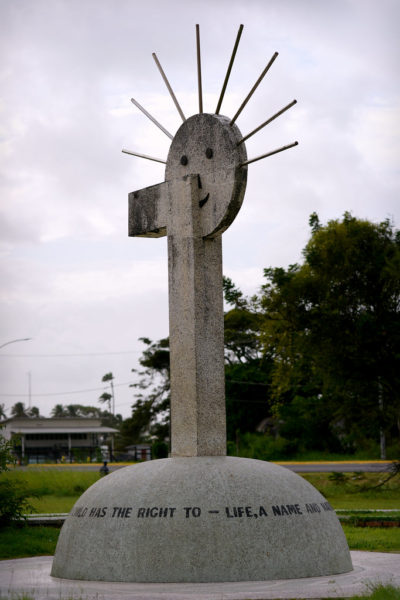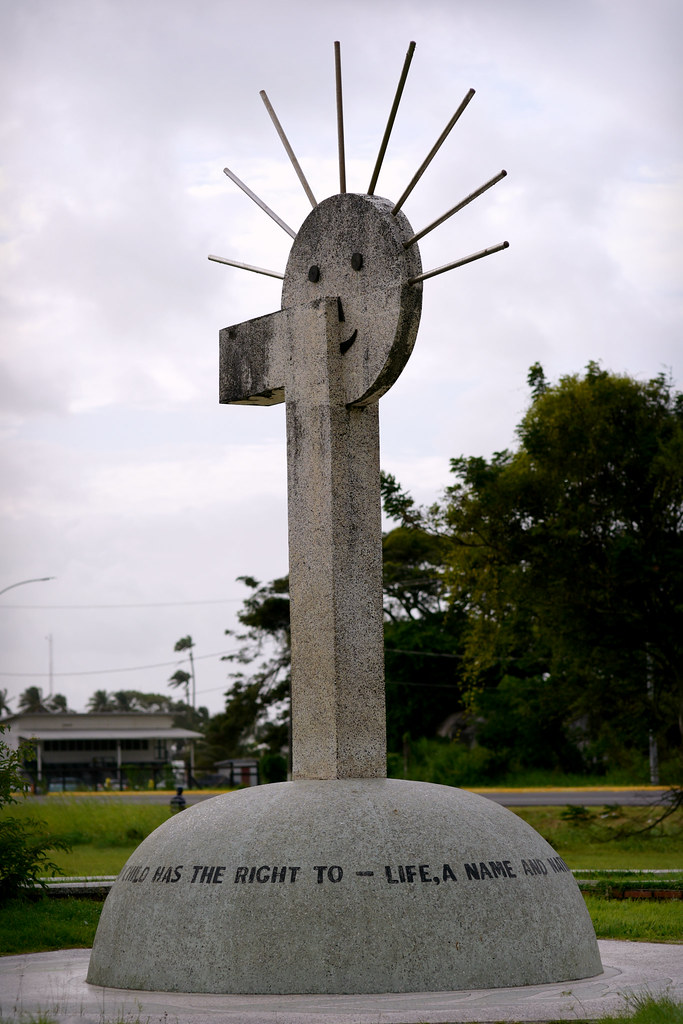Viewing from the Carifesta Avenue, Thomas Lands, Georgetown one can see the beautiful sight of the Children’s Millennium Monument located in the National Park. The children’s Millennium Monument designed by architect Michael Hahn was unveiled in 2000 by Janet Jagan to symbolize the development, strength and growth of all children of all races in Guyana.
What does the existence of the Children’s Millennium Monument represent?
The monument exists as a reminder to the nation that children are persons with social and legal rights who were important to the future of the nation.
Social Rights of Children
 Children are different from adults and there are many existing charters and covenants on human rights that give all human beings essential rights. Though small and young human beings, children were probably thought to at least have all those rights or only those accorded their adult counterpart. Yet the United Nations for Convention on the rights of child gives them rights solely because they are children. Nevertheless, a quote was said from the previous declaration of the rights of the child in the preamble to the UNCRC. It stated that ‘the child, by reason of his physical and mental immaturity, needs special safeguards and care, including appropriate legal protection, before as well as after birth’. Likewise, the Preamble of the African Charter of the Rights and Welfare of the Child (1990) recognises that ‘the child, due to the needs of his physical and mental development requires particular care with regard to health, physical, mental, moral and social development’. In essence due to children not being adults and with respect to the differences between child and adult, UNCRC gives the rights it does to children. This include the right not to suffer abuse or neglect.
Children are different from adults and there are many existing charters and covenants on human rights that give all human beings essential rights. Though small and young human beings, children were probably thought to at least have all those rights or only those accorded their adult counterpart. Yet the United Nations for Convention on the rights of child gives them rights solely because they are children. Nevertheless, a quote was said from the previous declaration of the rights of the child in the preamble to the UNCRC. It stated that ‘the child, by reason of his physical and mental immaturity, needs special safeguards and care, including appropriate legal protection, before as well as after birth’. Likewise, the Preamble of the African Charter of the Rights and Welfare of the Child (1990) recognises that ‘the child, due to the needs of his physical and mental development requires particular care with regard to health, physical, mental, moral and social development’. In essence due to children not being adults and with respect to the differences between child and adult, UNCRC gives the rights it does to children. This include the right not to suffer abuse or neglect.
Legal rights of children
Children are given rights under the United Nations Convention on the Rights of the Child that are not necessarily protected by the domestic law of the country. Moreover, these rights are violated entirely throughout the world. Therefore, it is important to recognise that moral rights do not have to be legal rights, just as legal rights should not be seen as moral rights. For instance if someone has a moral right to something, that doesn’t guarantee that the same right would be legally recognised.
Throughout history demands for legal rights have been driven by the view that whatever persons are morally entitled to they should also be legally entitled to have them.
Features of the Children’s Millennium Monument
The top of the monument is spherical in shape and symbolizes the rising of the sun which represents the development of children. This spherical shape rests on a vertical part which is an upside down ‘L’ and depicts the strength and growth of children. The arm of the ‘L’ shows that children had to reach for the stars. The base of the monument which is shaped like a ball represents the world and the six benches around the monument represents the six races of Guyana.
In a feature address at the unveiling of the monument, it was pointed out that children’s rights were being promoted all over the world, and children themselves were raising the issues. These issues were in connection with juvenile justice, education, environment and respect for parents, among other things which was highlighted during a Children’s Parliament. These very issues were also raised during the Commonwealth Children’s Summit held in Durban, South Africa.
Juvenile Justice for the younger generation
The term, ‘juvenile justice system’ refers to institutional arrangements embodied in public law by which the country have a compulsory intervention either in response to offences committed by minors, or to protect them from harm or risk of harm, or to meet their welfare needs.
The difference between participation and protection rights have some connection to an influential distinction between ‘justice’ and ‘welfare’ models of dealing with young offenders. The distinction can broadly be explored as follows: A welfare model which points out the needs of the child, viewing them as the source of his/her misdeeds. Its purpose is to rehabilitate or to treat the child, and not to punish him/her for their errors. In contrast the justice model focuses on the deeds of the child, viewing those that are misdeeds as meriting appropriate penalties.
The National Commission on the Rights of Children (NCRC) was made aware that some children suffered punitive measures that were meant for adults and so juvenile justice was an area that was being looked at. The reason being was to bring about closer collaboration and greater understanding of the rights of children to legal protection.
Education of Children
Every child has the right to an education is a common statement circulating the atmosphere. Education paves the way to a successful and productive future which makes it more than just a fundamental right. More children are now taking part in early childhood education, which is critical for their developing brains. Globally, enrollment in early childhood education increased from 33 per cent in 1990 to 50 per cent in 2011.
Adding to that, flogging in schools as a form of discipline was also taken into consideration.
Environment which influence the rights of children
Referring to the environment, the Minister pointed out that schools countrywide were being rehabilitated to make them more conducive to learning. Other aspects of the environment included receiving attention and keeping their environment clean.
Respect for parents in observing children’s rights
Children have rights but they also have a responsibility to respect their parents, elders and others to show love and care as outlined by the Minister in her feature address during the unveiling of the monument.
She told the children to regard the monument and the area surrounding it as their space and help to keep it looking tidy by not littering it and not picking the flowers planted around it.
References
- https://www.landofsixpeoples.com/news/ns003163.htm
- http://nationaltrust.gov.gy/history-of-georgetown/historic-thomaslands/
- https://lawexplores.com/childrens-rights-and-juvenile-justice/
- https://www.unicef.org/crc/index_73893.html








1 Comment